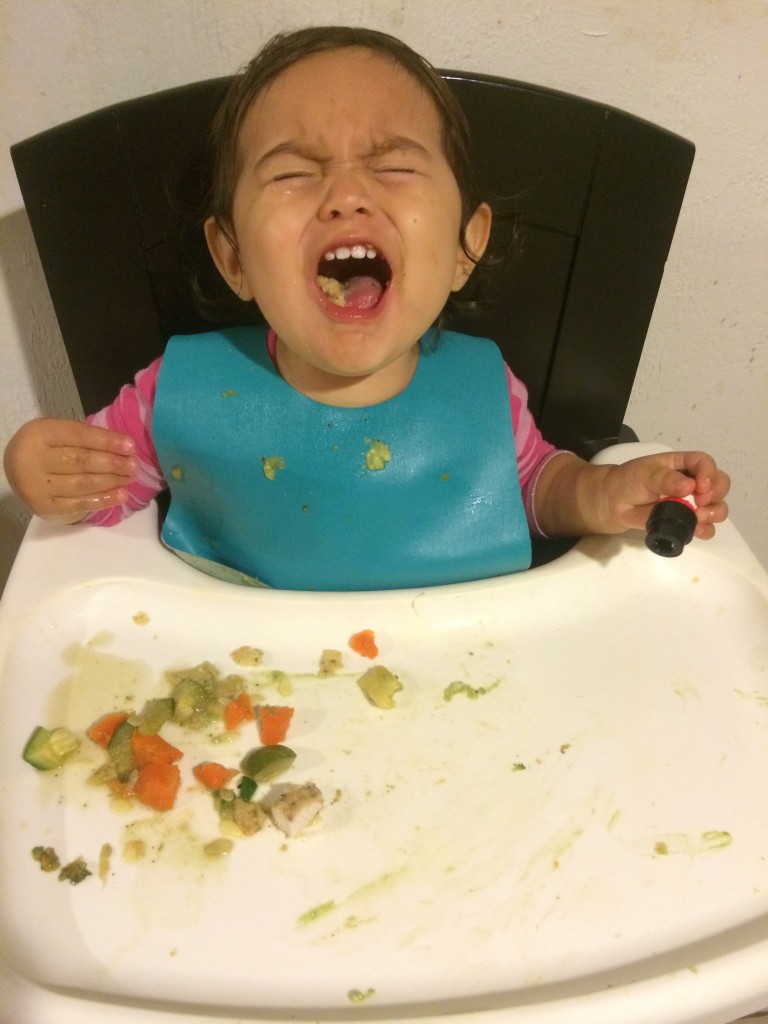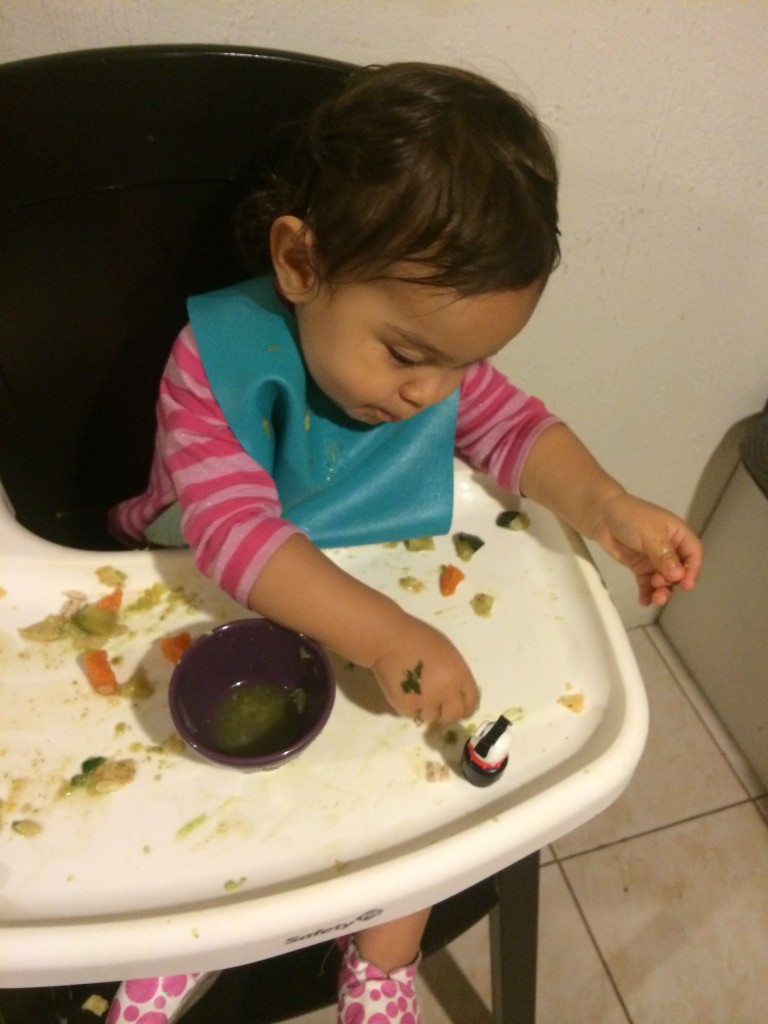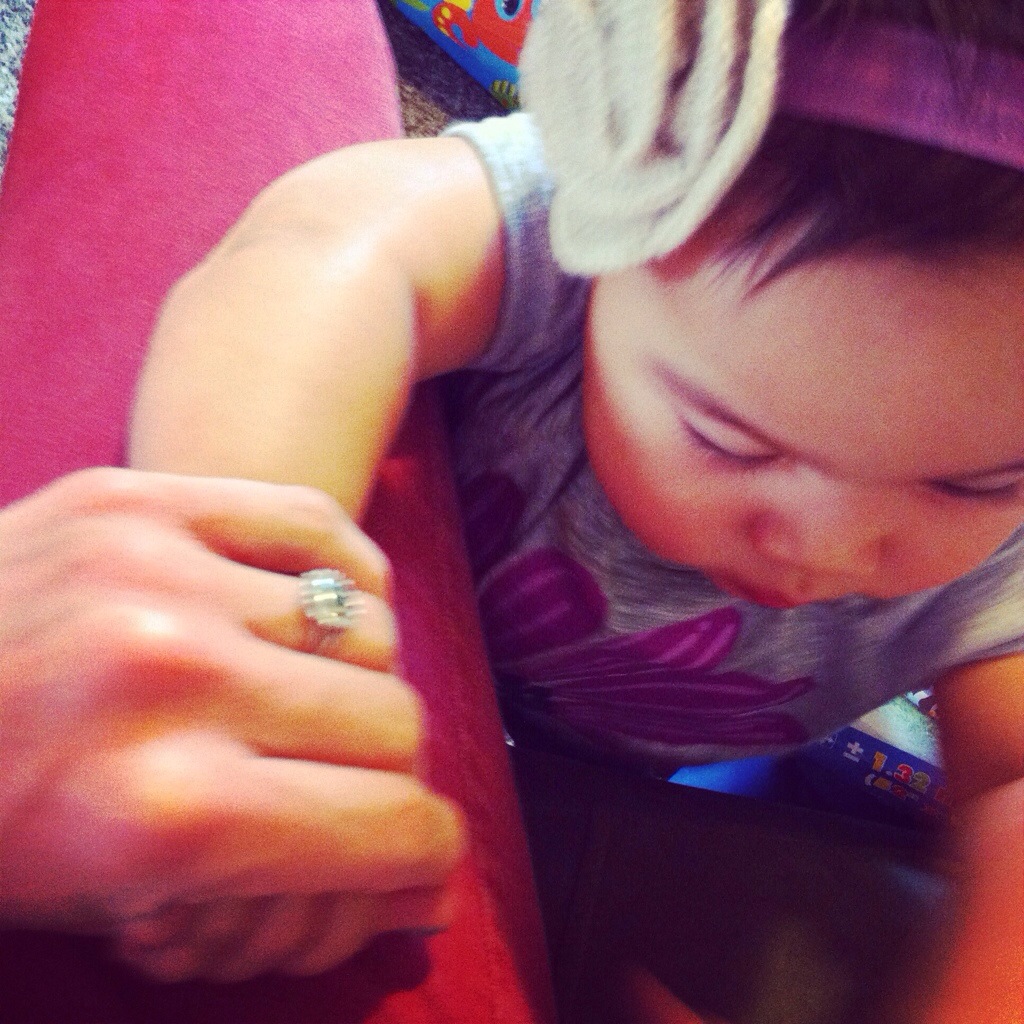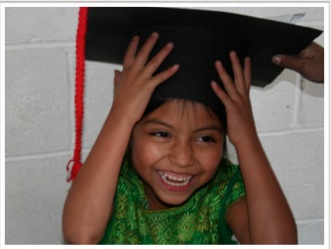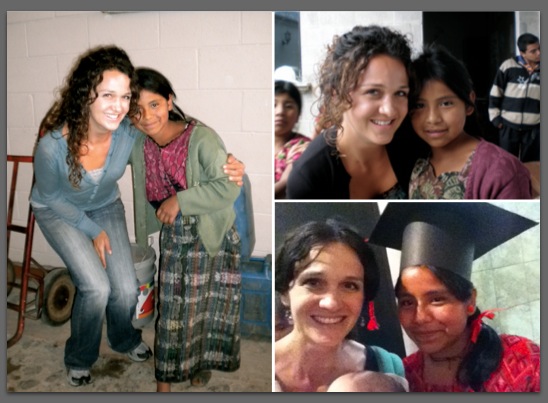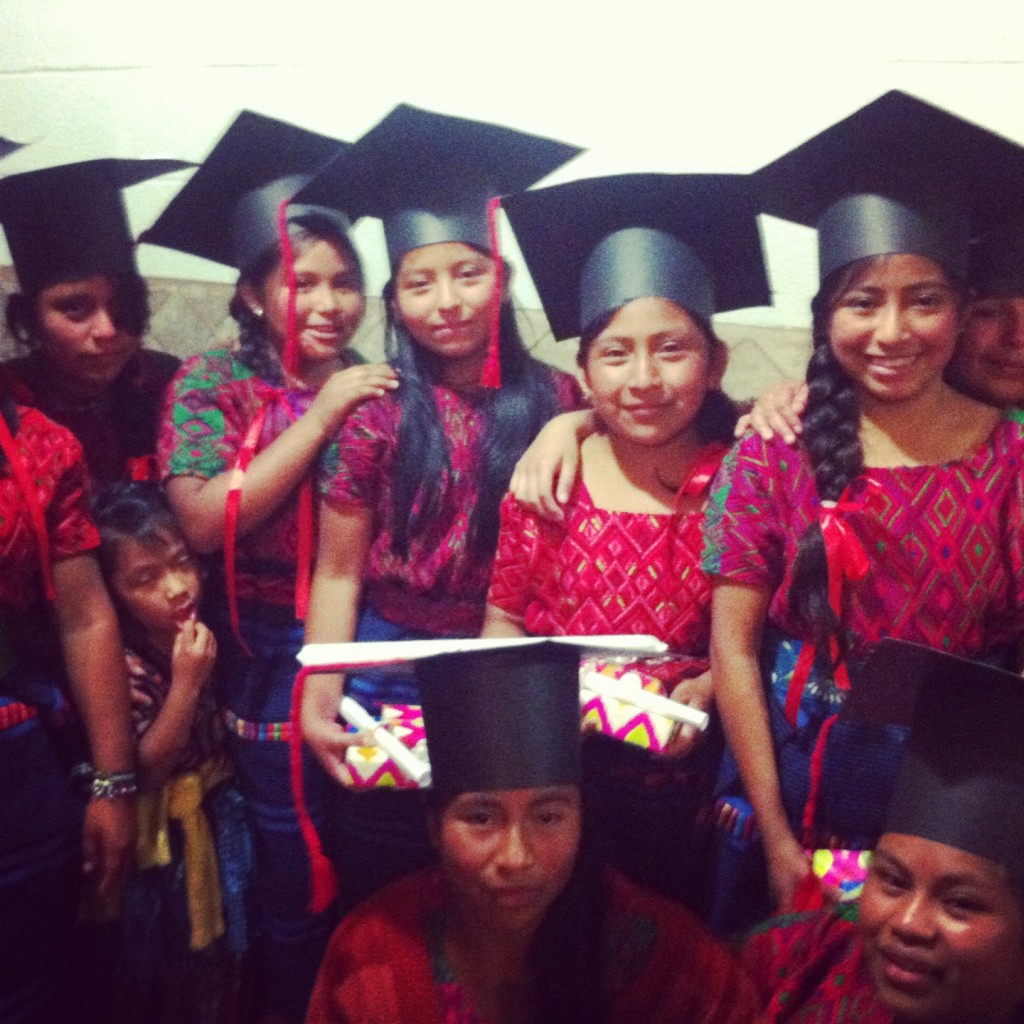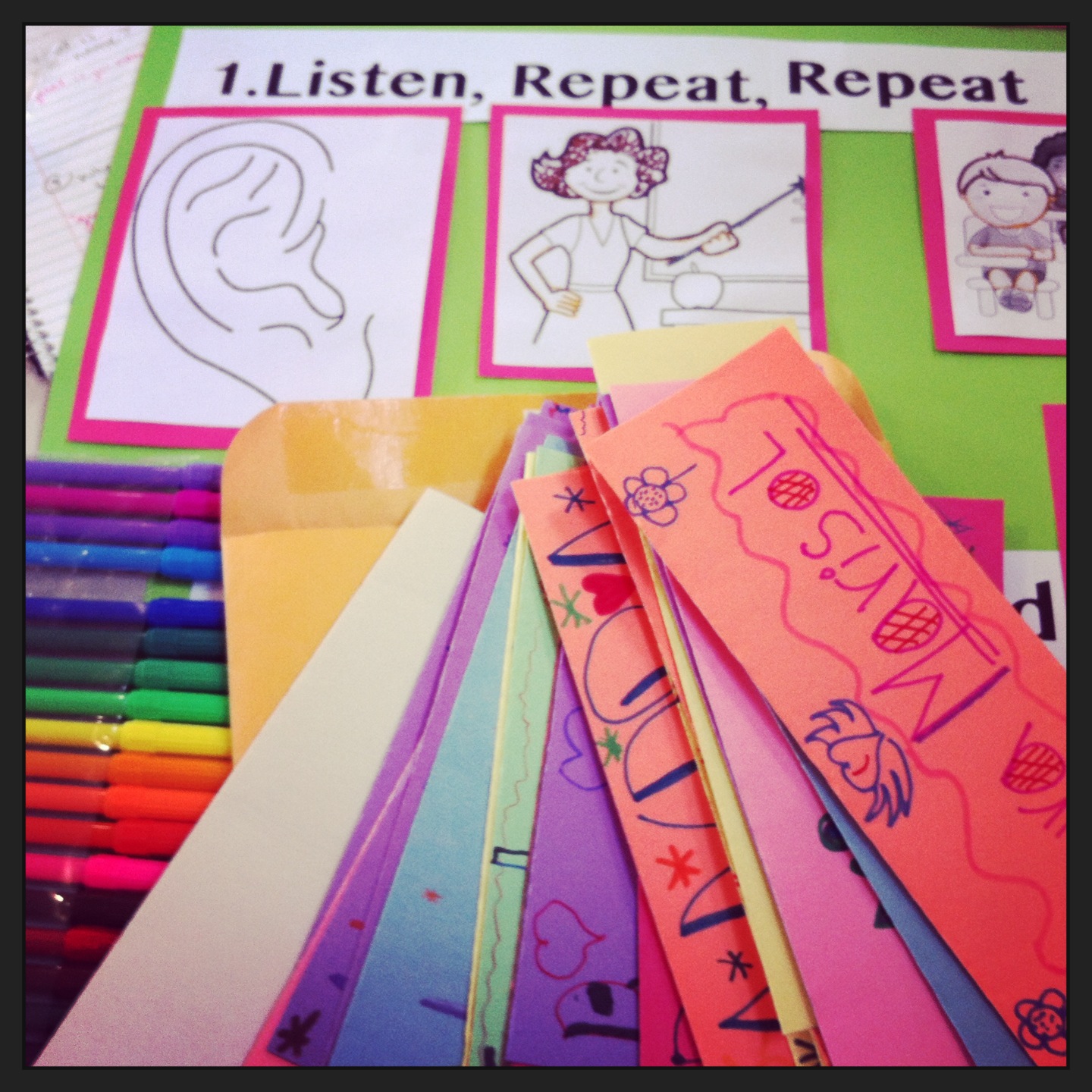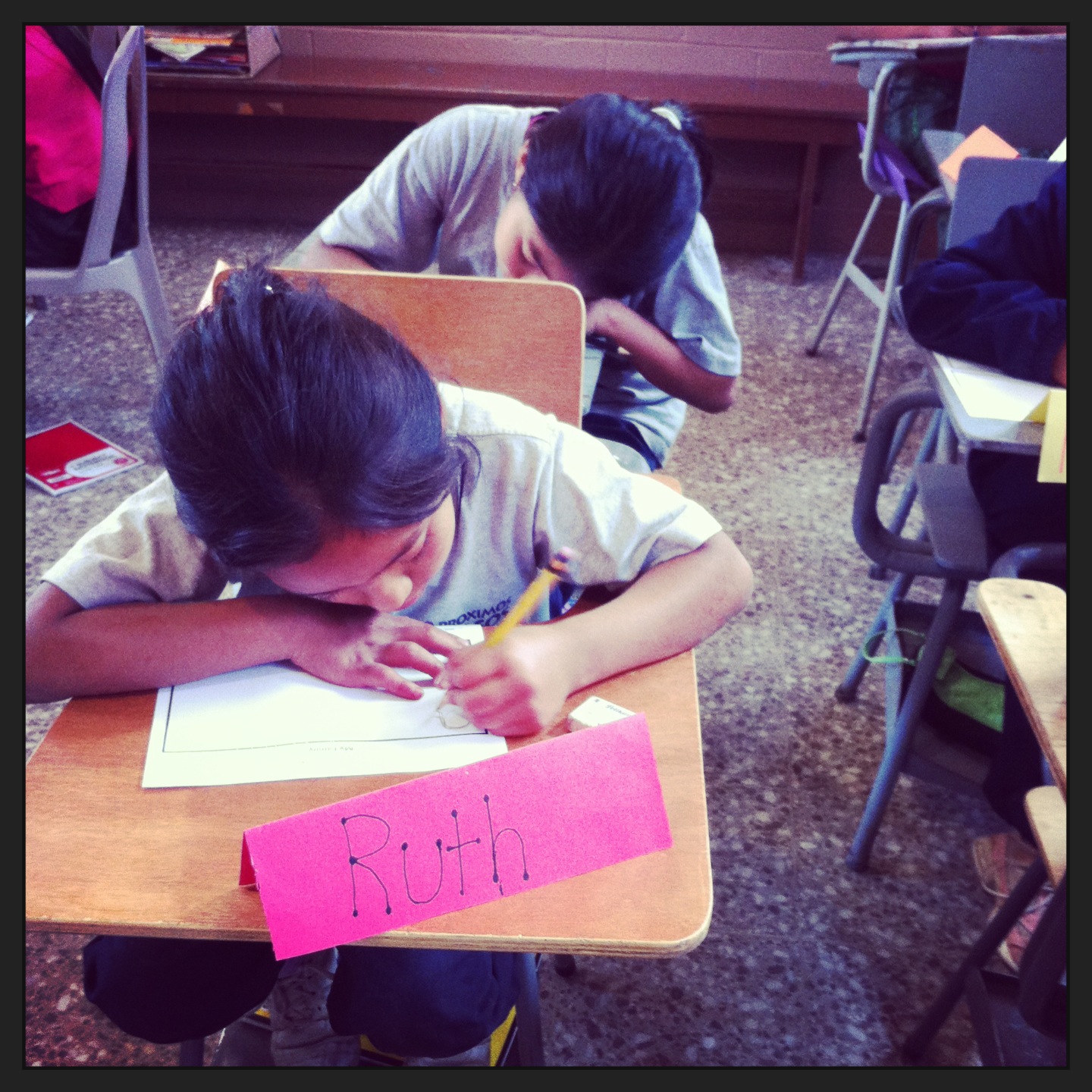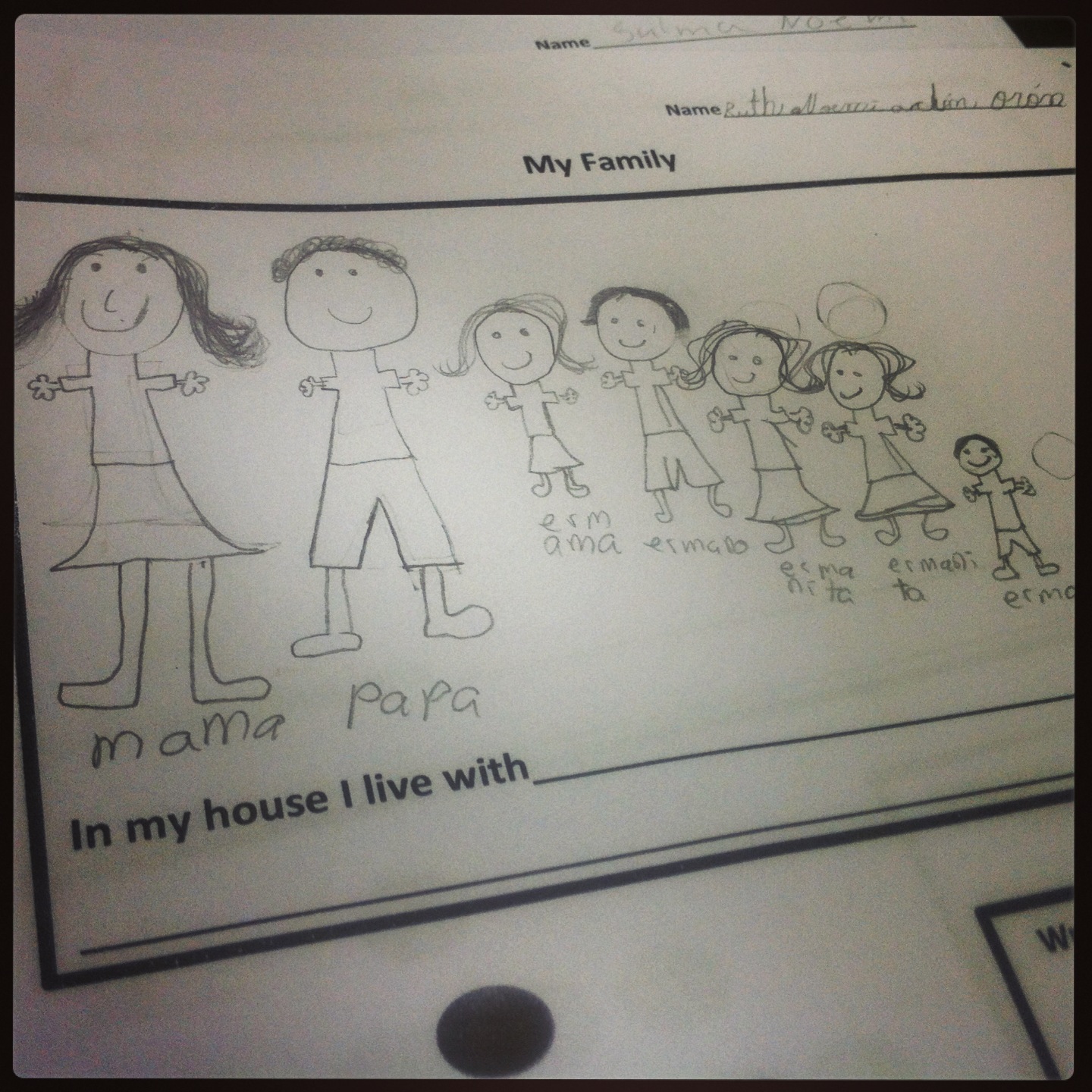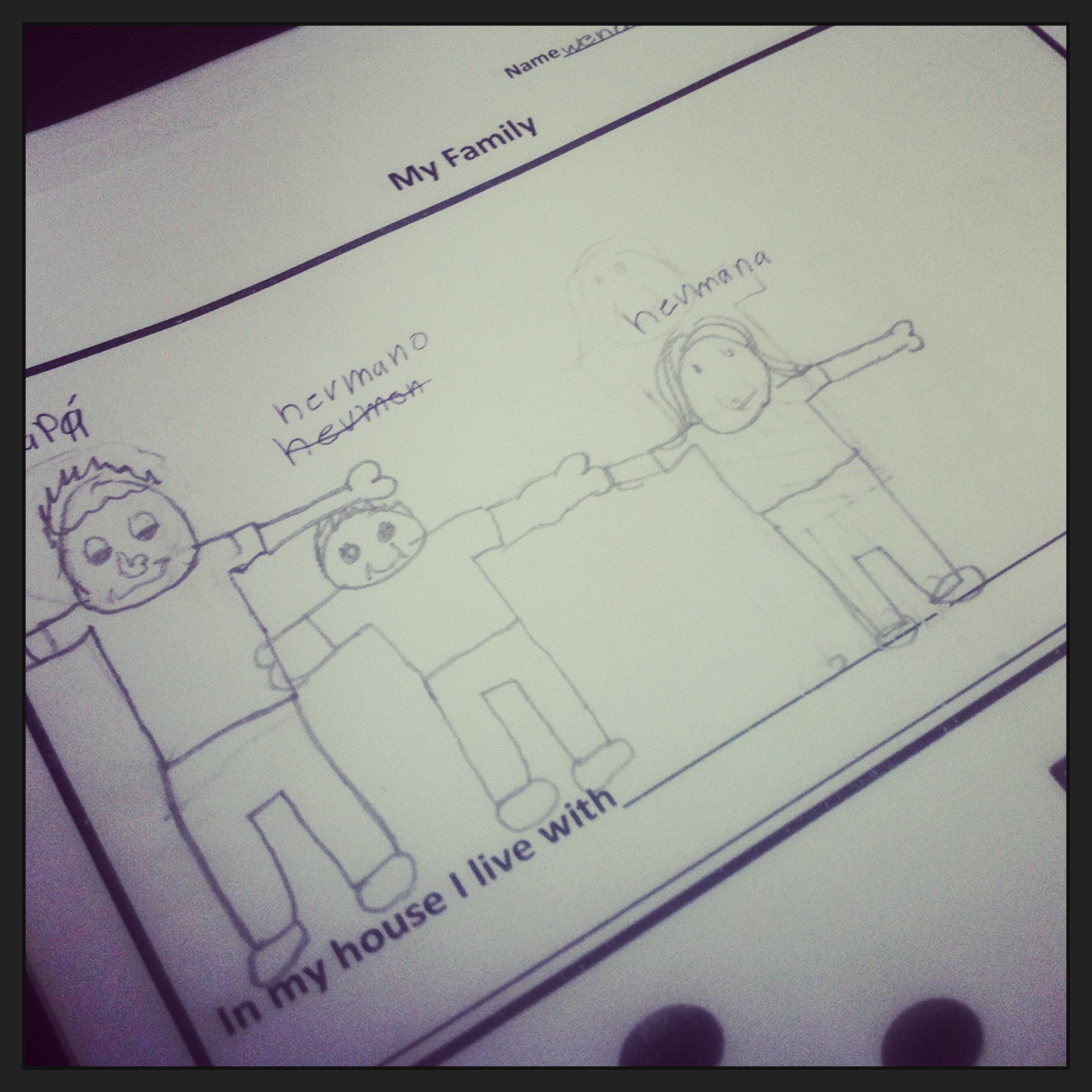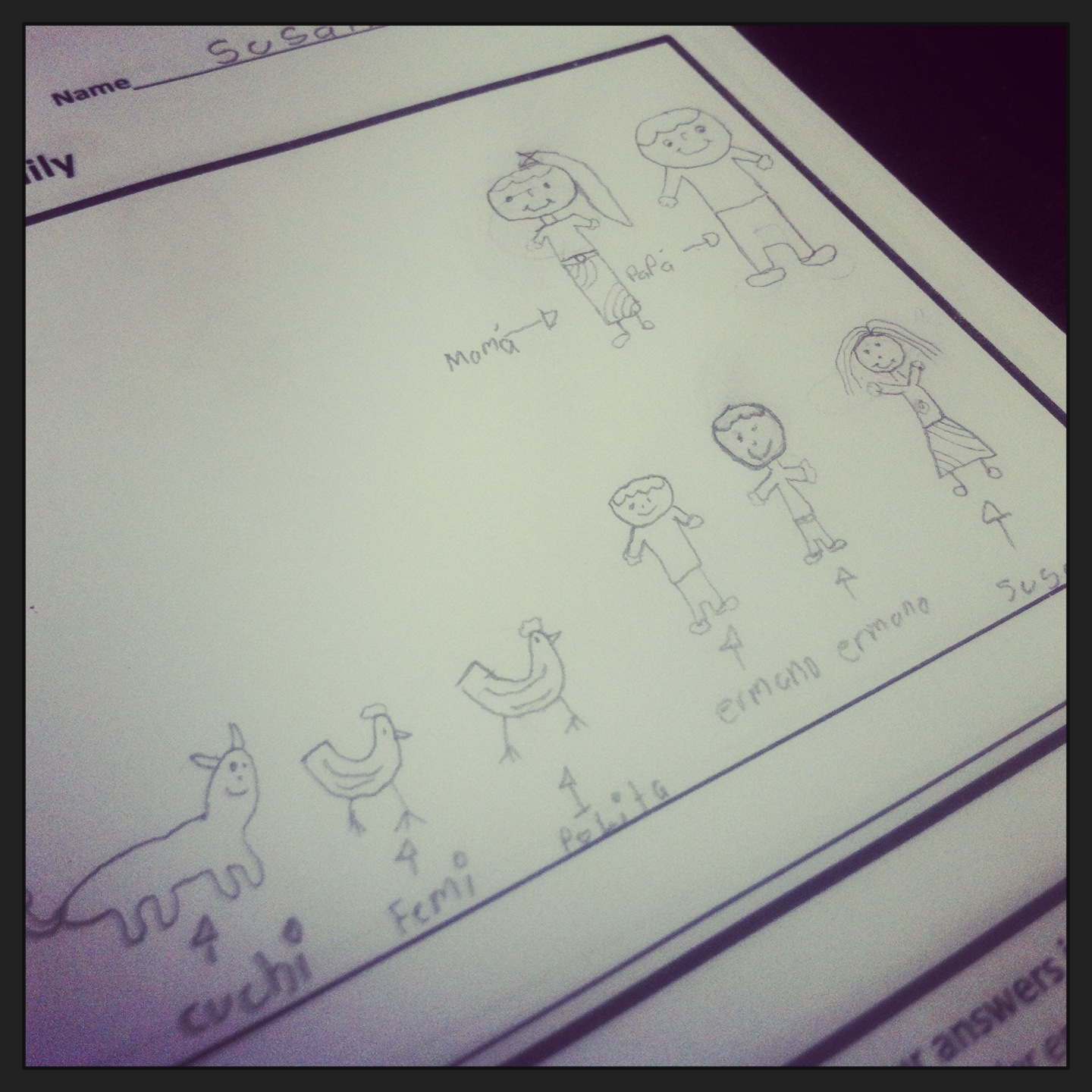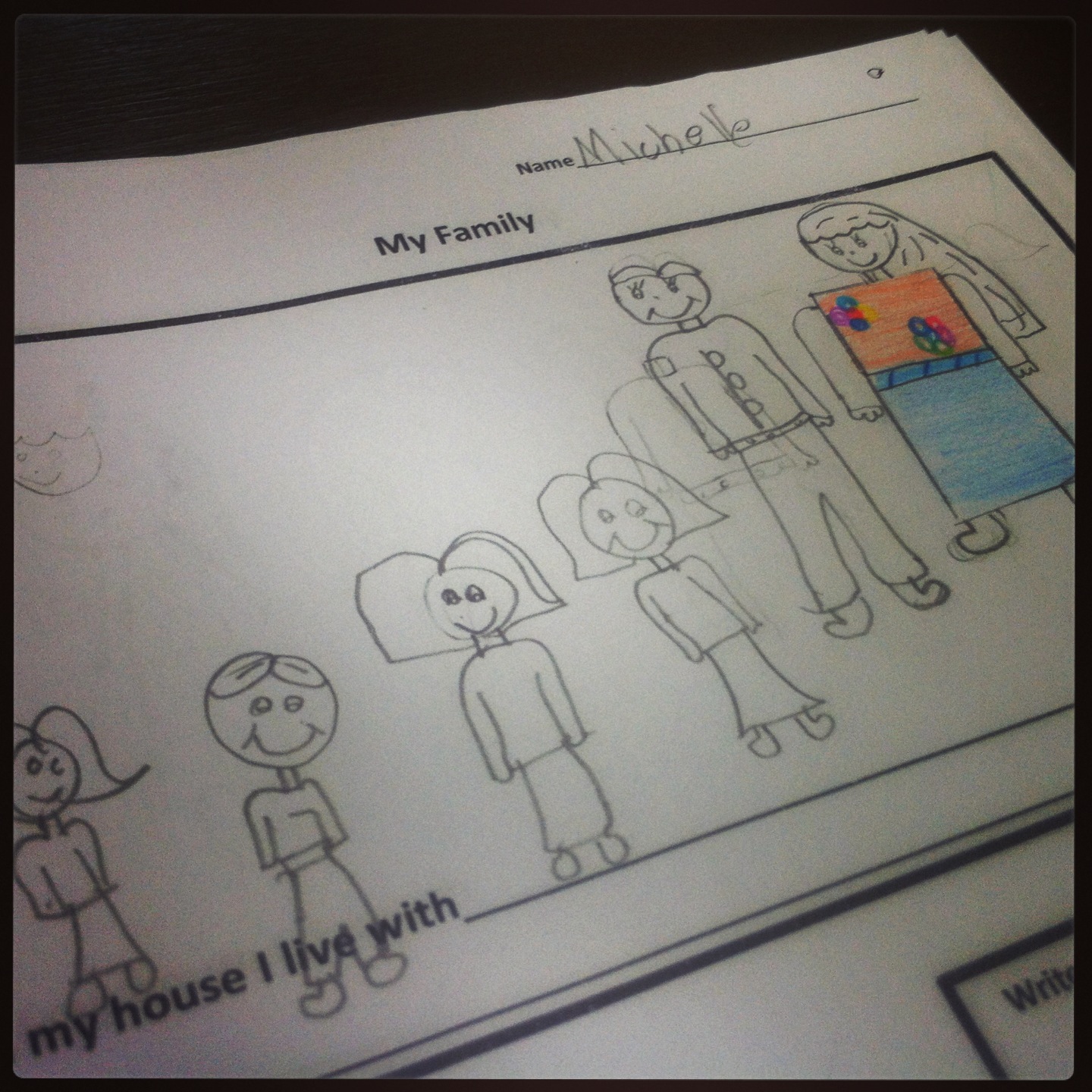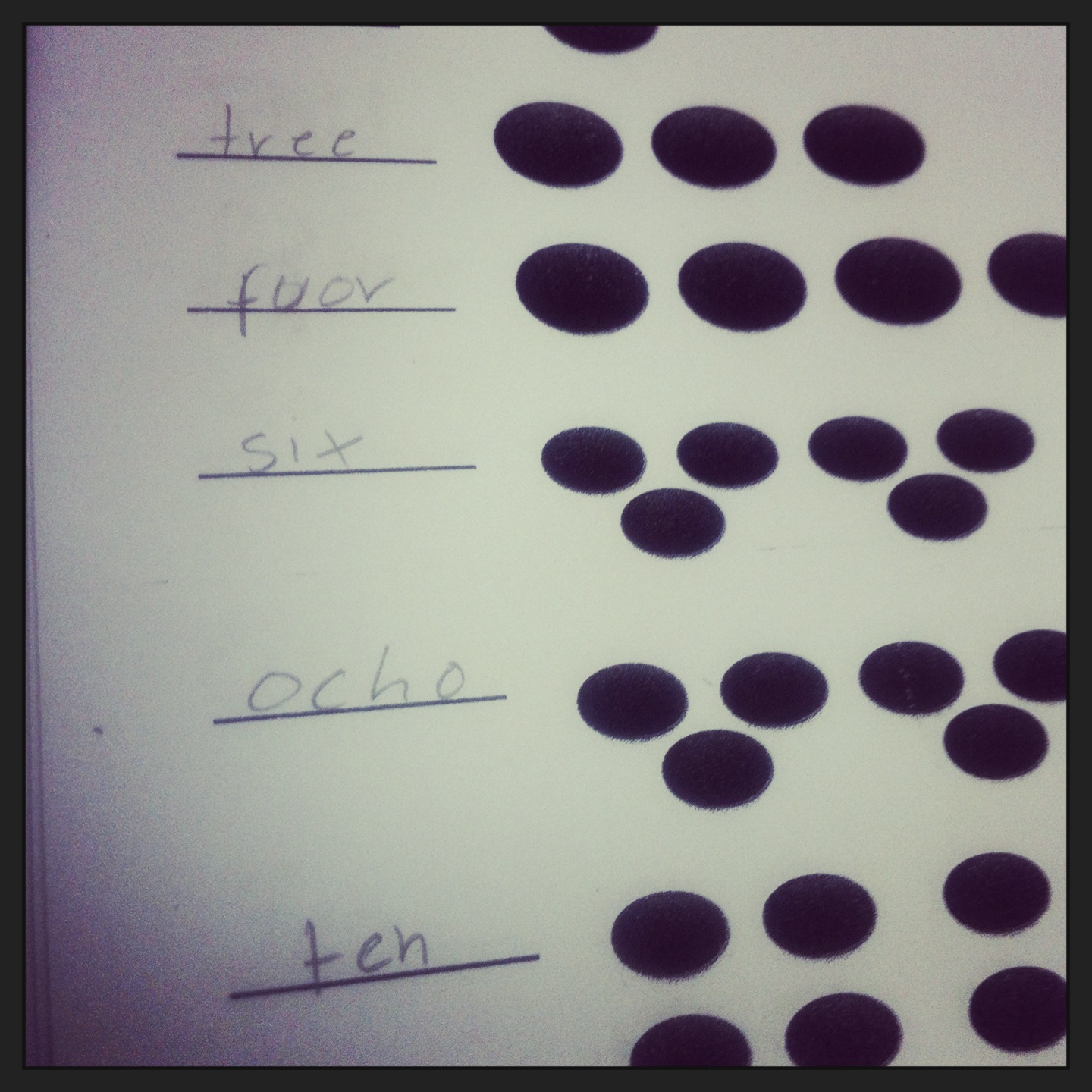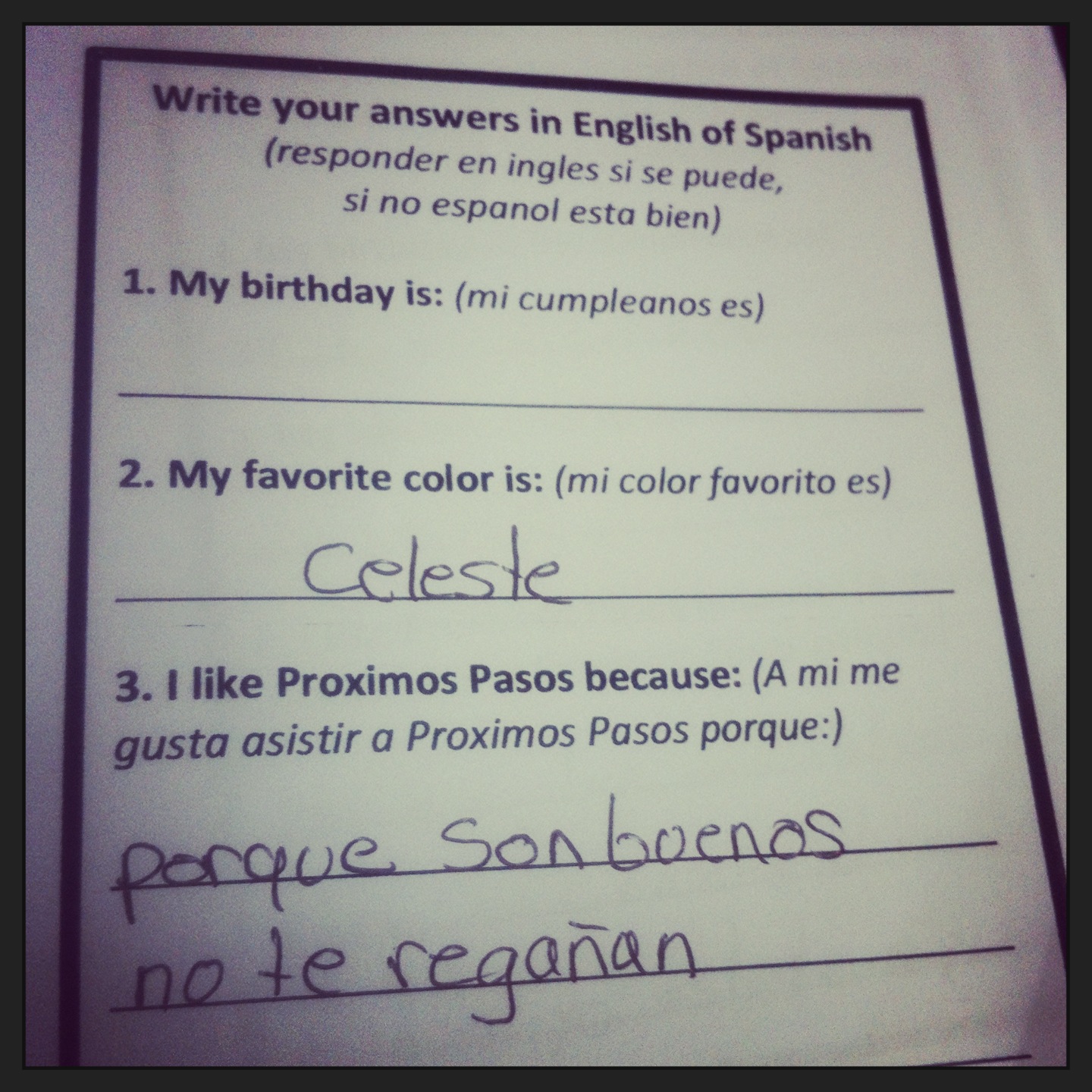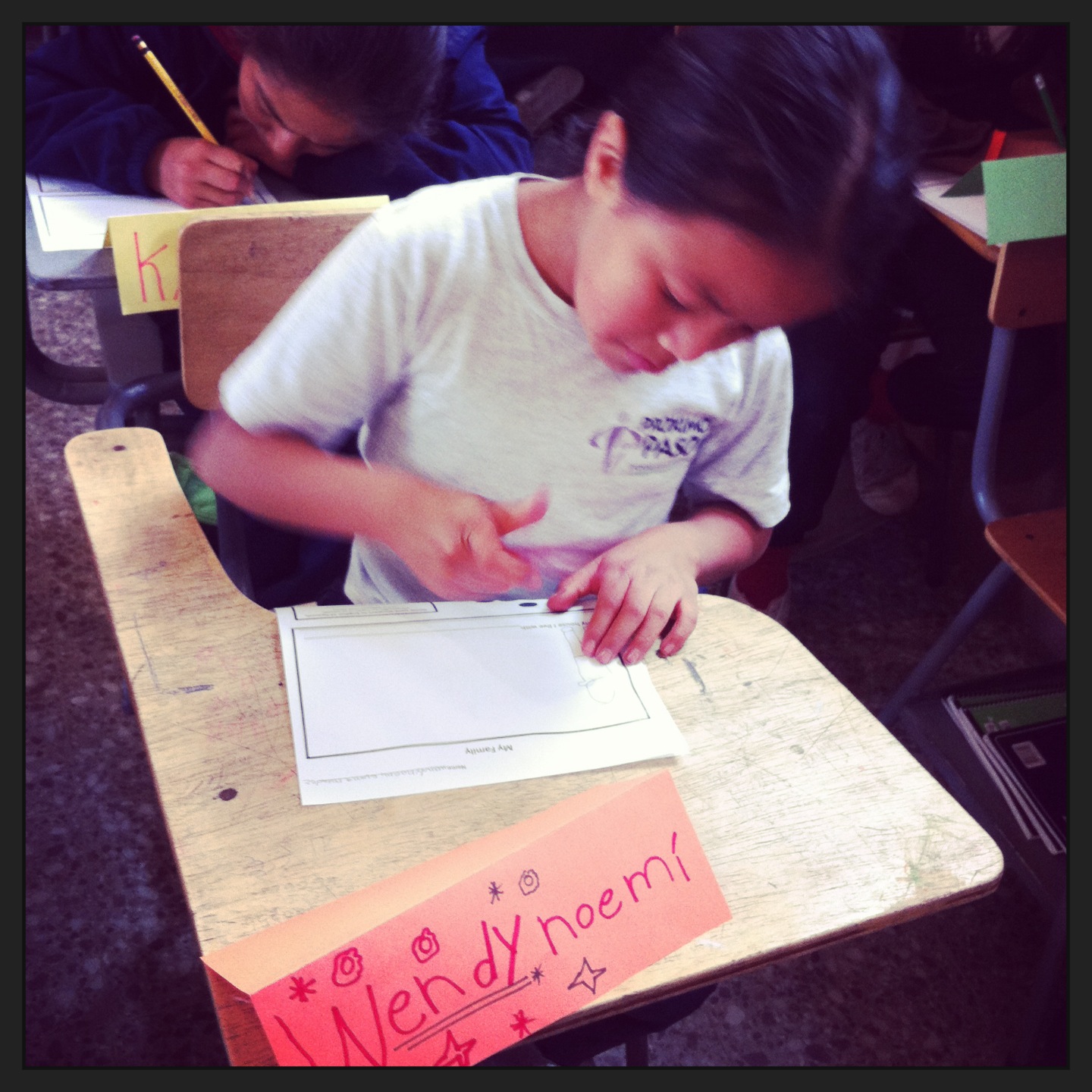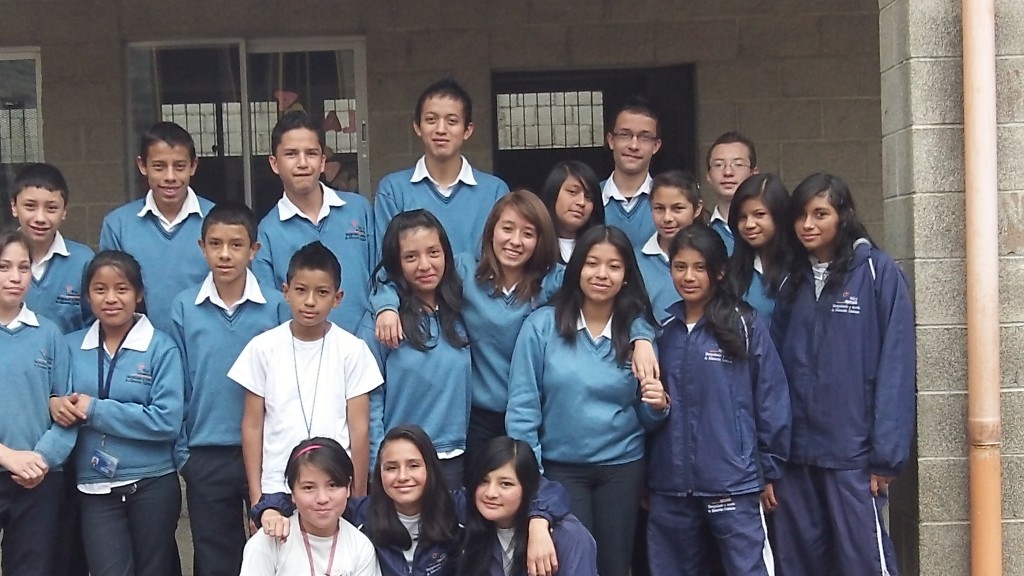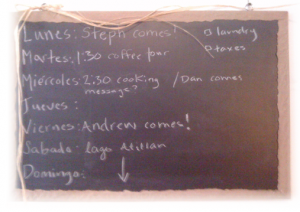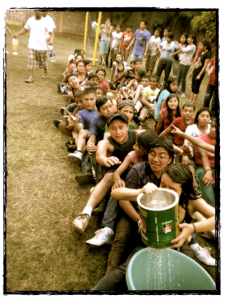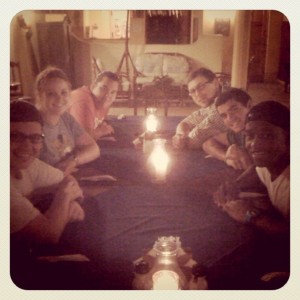Teaching & Kids

When we were in the states a few weeks ago, a sweet mom, whose own kids are earning drivers’ licenses’ and college degrees, pulled me aside one afternoon after seeing how much Elena talked about “Frozen.” (which she affectionately calls, “Oafen” and may or may not have watched a total of 27 times while driving from CA up to WA)
“I got something for her, but you I wanted to show it to you first to make sure you’re ok with it.”
I thought that was super kind and thoughtful of her.
She proceeded to pull out a blue sparkly, Elsa Barbie doll. “And look, if you push here. She sings.” Let It Go, Let It Goooooooooo.”
I know all of you parents of young ones right now, are like, Noooooooooo.
I smiled, ignoring all of my anti-princess-no-Barbie-doll-feminist-leaning tendencies.
“She will love it.” I said.
And she did.
Elena’s big eyes and curious fingers, wasted no time in figuring out that blue button. Elena was tiptoeing around the kitchen with her singing Elsa, who she calls “ah-chay,” twirling high above her head.
She was mesmerized. And I was kinda dreading the next 6 days our trip.
I wouldn’t exactly say I am anti-Disney princesses, but I am definitely not for them. I don’t like the message they portray to young girls. The whole princess-culture, that says your worth is based on your external beauty. It seems to only reinforce what so many woman and girls grow up fighting against.
I was explaining all of this to my husband on one of our 4-hour car rides. His eyes were focused straight ahead, but I knew he was listening. “It’s just, I don’t want our little girl growing-up thinking some prince will come and rescue her, you know? I want her to know that women are made for so much more. I want her to be brave and confident and full of compassion and gratitude. I want her to be strong and smart and know that her outer beauty is only a reflection of her inner beauty.”
I sighed loudly, expecting him to nod along and agree with me, but he didn’t.
“Michelle, she’s not even two.
“ok. You’re right. She’s not even two.” I repeated to myself as I imagined her singing ‘Let it go’ for the next 10 years.
. . .
We got home last week and while un-packing my suitcase, I came across the singing Elsa doll. I was tempted to hide it. She won’t remember if Elsa just “disappears,” I thought.
But something stopped me.
I don’t want my personal preferences to get in the way of paying attention to what my daughter likes. And right now, she likes Frozen. So I will play with Elsa and talk about Anna and Olaf and buy her Frozen pajamas and underwear because she likes it. I will enter her world because that’s the only way I know how to really understand someone. Sure, as the parent I will set boundaries. We will not watch Frozen every day.
But I will care about Frozen, because she cares about Frozen.
And if in five years she starts caring about inch-worms and frogs and beetles, I want her to know I will do my best to care about those things too.
If in nine years she comes home from school crying because she didn’t get invited a friend’s birthday, you better believe I will provide hugs and empathetic nods. I will care because she cares. Feeling left out of a birthday party is sad and hard at any age, but especially when you’re nine.
And maybe in twelve years, if she starts caring about a silly boy band, I will care about that silly boy band, too. I will listen with her and try to remember their names and let her put up posters in her room.
And if in seventeen years, her interests move on from a boy band to an actual boy, I will tell her he’s welcome to come over. I will place my hand on her daddy’s arm for reassurance, and show her that if she cares about someone we will, too.
If in twenty-one years she comes bouncing in talking about an internship where she gets to study malaria prevention, but all I hear is “gone” “whole summer” and “not-deadly,” I will keep my thoughts to myself and congratulate her. I will hug her and ask her to tell me more. Because if something makes her this excited, I will want to understand why.
And if in twenty-five years she says she wants to move to another country, one where I don’t speak the language or understand the culture, my heart might sink for a second, but I will buy a plane ticket to visit and see her life. I will pray for her protection and growth, not that she changes her mind. I will sit awkwardly waiting when I don’t understand what’s being said and watch as she lights up, explaining to the taxi driver where we’re going.
Because loving someone means caring about what they care about.
It’s easy as parents to see our children for who we want them to become, but I think it’s sometimes all too easy to miss who they are right now. That’s why we need other people, a spouse, a friend and an observant older mom, who may see interests that we may not. You know, a fresh pair of eyes to notice how much a certain little one loves singing ‘Let it go.’ The truth is I can introduce my daughter all day to books, and climbing and colors and picking flowers. And I can hope that one day she’ll learn how to play the piano or join a soccer team, but for now she loves putting her baby dolls “nigh nigh” and singing with Elsa and Princess Anna. And that is just ok.
Gerber and I talk a lot about how in community development work, before people care what you know, they want to know that you care. And I think the same in true in parenting. Of course I want to teach our little girl all kinds of things, but I know before she is ever going to care about what I know, she has to know that I care.
So I will start by caring about the singing Elsa Doll.
Last week, Elena and I were on our way back from an afternoon errand. As soon as I pull up in front of our house, her little voice from the backseat both asks and exclaims, “Agua? Agua!”
I pull her out of the carseat, going over my mental to-do list that should be written down somewhere, but it’s not. Call Sandra. Email the hotel. Peel Carrots. I make a mental note to buy a planner for 2015.
Elena interrupts my thoughts, “Agua!” “Agua?” I smile, knowing very well what she wants.
I leave the diaper bag in the car, grab my phone and keys while setting Elena on the sidewalk.
“Ah-wa!” She points toward the cement basketball court.
She remembers. After it rains there are always puddles of water.
She squeals as she runs toward the court, one hand pointing toward her destination the other hand tightly wrapped around my mine.
I marvel at her excitement. She splashes her feet in the water and giggles.
She hops over to the next puddle and does the same. Water splashes, her little white shoes get wet.
She pauses and notices the dirt on the side of court.
She waddles over, and squats down. With one hand on the ground to sustain her, she uses her other to pick up a tiny rock. She holds it out for me to see, “mah-ma?”
I nod and offer my motherly, “wow.”
She tosses it into the puddle. It barely makes a ripple, but she laughs.
She walks over to the puddle, splashes her little feet and then picks up the rock and gently tosses it into the next puddle.
She watches it land, then runs over to splash next to it.
Then she goes back to the dirt to look for another pebble.
I snap a few pictures.
I ask her, “What did you find? “ so she knows I am still there.
I stay about three feet back from where I usually would be, too hesitant to ruin her playing.
She tries to run, but slips and falls down. Her pants get wet. All wet.
Her eyes meet mine for reassurance.
It’s ok. You’re just a little wet.
She seems consoled and begins splashing her hands in the water. The sleeves of her sweater absorb half of the dirty water. I restrain myself from interfering. I want to push up her sleeves or remove the wet sweater, but I don’t.
It will wash out, I tell myself.
Her face is now wet, a mix of dirt and water drops have landed on places I usually try to keep clean. But she is smiling.
She straightens her legs into a little mini downward dog pose and pushes herself up to standing. She runs back over to the first puddle. She finds another little rocks and picks it up and then tosses it into the neighboring puddle.
For 25-minutes I watch this continue.
I notice she has a pattern, a rhythm to her play. She is learning and discovering. She is having fun.
It is moment I realize, that I didn’t bring anything for her “to do.” We come to this little park often, but usually I wheel the stroller down with bubbles and a ball and sometimes snacks to share with friends we meet. I know those things are not inherently bad, but it made me wonder how often do I miss opportunities because I bring too much stuff?
• • •
I am a product of my generation and my country. The “if-I-don’t-buy-this-then-my-child-will-miss-out” parenting myth is strong and believable. Sophie the Giraffe, gotta have that. Stacking wood colored blocks, yep. Baby moccasins, of course. Books, yes, please, more books! There is poverty in privilege because I can choose to buy all of these things for my daughter. I could choose (and often do) fill up her shelves and our lives with stuff, but I often wonder when I say yes, to those things what I am I saying no to.
How often is the cliché true, less is more?
Months ago I read part of the book, Simplicity Parenting: Using the Extraordinary Power of Less to Raise Calmer, Happier, and More Secure Kids![]() . The idea is that in the US, we give our kids too many choices, too much stuff and too little time and so it goes through ways to de-clutter your stuff and your life, taking away screen time to have more family time, planning less activities, etc. It’s mostly geared for school age children, but I think a lot of the principles are applicable now.
. The idea is that in the US, we give our kids too many choices, too much stuff and too little time and so it goes through ways to de-clutter your stuff and your life, taking away screen time to have more family time, planning less activities, etc. It’s mostly geared for school age children, but I think a lot of the principles are applicable now.
• • •
So I am thinking about this as a parent, but also a person.
I am by no means the poster child for simplicity. This blog is called Simply Complicated, with slightly more emphasis on the “complicated.” Just look at my computer desktop or how many drafts I have saved in my email (454!). I can pack-up tw0 50lb suitcases with tightly rolled clothes, cushioned around picture frames and cute anthropologie bowls like it’s my job. I have “wishlists” saved in my phone of things I want to get when we’re in the US later this month. I am usually a more is better, always be prepared kinda person. Ask anyone who knows me, simple I am not.
• • •
So I am thinking about this idea of less is more on a personal level, but also on a societal level.
I would say one of the most frustrating and perhaps best parts of living in Guatemala is that I have fewer options. By nature there are just less choices here. There is no Target, no 2-day amazon prime, or return policy. What you buy is yours and when the store if out, it means they’re really out. There’s no backup. You can find things like frozen fruit in pre-packaged bags and pre-chopped bags of broccoli or lettuce, but you’ll pay 5 times as much for it. Convenience and efficiency are not a high value in Guatemala. But you know what is? Contentment.
I don’t think I am alone when I say, I feel more content here, than I do when I am in the states. And it’s not because I have found some secret recipe for contentment. No, I think it’s more circumstantial. Less is more. When you have fewer options, I think in general you’re more grateful for what you have.
• • •
So, I am left wondering how do you raise kids in relative material wealth, who still grow up to be content? Does contentment grow out of the very fact of not having enough? By buying our kids too much stuff are we taking away the very opportunity to practice being content?
It’s privilege of the wealthy that even get to look at this whole notion that less is more. I know for many families growing up in poverty, less really is less. There is nothing to glorify about poverty. My husband can attest that there is nothing nostalgic about never getting a birthday present or not ever getting a new toy. He never had his own books to read or crayons to color with. Sure, he learned how to be creative and climb trees and run through corn fields, but it wasn’t cause his parents were trying to give him “opportunities”for play and discovery or practice being content, it was really because there were not any other options.
When is less more? And when is it really less?
It seems fewer options leads to more contentment, but no options leads to fewer opportunities.
Maybe the question I am learning to ask is, by saying yes to (buying/bringing/getting) _______ ____ for myself or our daughter, what am I saying no to?
• • •
I think about that day at the park last week. About the simple joy of watching Elena play.
As the sun begins to set, I carry home my wet, dirty and smiley, little girl. I set her down on the doormat before walking inside. She puts her colds hands on my cheeks as I lift up one leg at a time.
“Let’s get these dirty shoes off you.”
I peel off her wet pants and stained socks. I lift her shirt and sweater up over her head and kiss her bare bell button. She laughs and squirms away.
I leave her clothes in a pile by the front door, thankful that I can throw those in the washing machine as soon as she’s in bed. I pick her up as we march up the stairs for bath time. “Bah?!”
Yes, time for a bath. And then night, night!
I smile as touch my nose to her hers.
She can’t yet say it, but I have a feeling we both went to bed that evening feeling quite content.
P.S. Look, her curls! They also make me quite content! xo
This is not a “how to get your kid to eat broccoli post” because the truth is, I just don’t know. Elena still won’t touch it. Just like I don’t think there is one way to raise kids, there is definitely not one way to feed kids. I feel fairly confident that usually by 5 years of age most kids can eat by themselves without a bib (can I get an, amen?!) and usually eat a variety of food options. With that being said I think the years between 1-4 can feel like a daily struggle or battle for some.
Just like there are kids who are naturally good sleepers and dream nappers, I think there are kids who are naturally good eaters. If you have one of those, just count your blessings and ignore this post  For everyone else here’s what I have learned, I tend to think there are three type of kids: 1) those like I said who are naturally good, easy eaters 2) those who are semi-adventurous eaters, but have strong wills and 3) those who are very picky eaters and have strong wills. Elena probably falls into the number 2 category.
For everyone else here’s what I have learned, I tend to think there are three type of kids: 1) those like I said who are naturally good, easy eaters 2) those who are semi-adventurous eaters, but have strong wills and 3) those who are very picky eaters and have strong wills. Elena probably falls into the number 2 category.
So, here’s a little background. Elena has always been a good eater. I mean she came out of the womb, rooting her little mouth, looking for something to latch on to  She was (is) a good nurser, has always gained weight and was super interested in food around 5-6 months. We tried the whole puree route and to be honest it was just a struggle. She didn’t seem to like the consistency and I wasn’t too keen about having to prepare something separate from her. By default, we started baby led weaning. We just started giving her bigger pieces of whatever we had to gnaw on starting around 7 months. It just worked for us. She was pretty content to hold and suck on a piece of apple or try and gum a piece of sweet potato and I loved not having to blend and puree baby food. Around 8 months she figured out the pincher-grasp pretty quickly and was quite a happy girl being able to pick up her frijoloes one at a time. We still did some soft foods, but only those that naturally come like that, like avocados or oatmeal. But chicken, carrots, watermelon- all big pieces.
She was (is) a good nurser, has always gained weight and was super interested in food around 5-6 months. We tried the whole puree route and to be honest it was just a struggle. She didn’t seem to like the consistency and I wasn’t too keen about having to prepare something separate from her. By default, we started baby led weaning. We just started giving her bigger pieces of whatever we had to gnaw on starting around 7 months. It just worked for us. She was pretty content to hold and suck on a piece of apple or try and gum a piece of sweet potato and I loved not having to blend and puree baby food. Around 8 months she figured out the pincher-grasp pretty quickly and was quite a happy girl being able to pick up her frijoloes one at a time. We still did some soft foods, but only those that naturally come like that, like avocados or oatmeal. But chicken, carrots, watermelon- all big pieces.
Then right around 12 months she started wanting to do everything ALL.BY.HERSELF. Which is hard, especially when most 12 months old aren’t quite coordinated enough to scoop, and spoon and fork things by themselves. She also started refusing certain foods that she had always liked before. She would throw food when she got frustrated or squish it up in her hands. Let’s be honest, we were all a little frustrated. Since they say you should choose your battles, I knew I didn’t want eating to be a battle.
I would say my motto for baby feeding has been: easy and healthy. It’s actually kind of my motto for cooking in general. I also wanted to give Elena food that we ate. Partly because it seemed easier, and partly because it seemed healthier. Win, win no?
And can we just agree that there is nothing about feeding a baby is clean? The floor underneath her high chair and that white wall you see in the pictures is always kiiiiinda dirty. And I feel like one of us is always cleaning off her high chair tray. Thank you, Gerber!
Ok, so here is what has been working for us (at least for now, the 12-15 month stage):
1) Make Eating Fun
In the long run, I want my daughter to have a healthy sense of eating and food. So if that means for now, we make food sometimes about play I am ok with that. I mean eating should be enjoyable, right? I think they key is having something different or an element of surprise. Sometimes it’s this doggie puppet, sometimes a monkey or sometimes just an extra fork  For whatever reason, when her doggie helps her eat her carrots it’s a hundred times more fun then I when I say, Elena eat your carrots. (Warning: choose something that can be easily washed. She’s been pretty good about knowing she can’t hold or touch these animals, but every now and then they get smeared with bean juice L
For whatever reason, when her doggie helps her eat her carrots it’s a hundred times more fun then I when I say, Elena eat your carrots. (Warning: choose something that can be easily washed. She’s been pretty good about knowing she can’t hold or touch these animals, but every now and then they get smeared with bean juice L
2) The Beauty of the Dip
Have you ever seen your little one try to scoop out their yogurt with a spoon and then by the time they bring it to their mouth it’s all dripped off onto their bib. Yes? Like 1000 times, huh? Me too. Solution: Dipping. Again, long run I would love for my daughter to know how to use a spoon. One day she will, but in the mean time we do lots of dipping. Carrot sticks in hummus. Toast in yogurt. Chips in guacamole. You get the idea. Works best when the “dipping item” is cut long and skinny, like the size of your pinky finger. Elena is a pretty indpendant dipper now  Also, if I would have know about these earlier I may have gotten one for her. Genius. Pure Genius!
Also, if I would have know about these earlier I may have gotten one for her. Genius. Pure Genius!
3) Freeze it
ok, so this probably only would work with yogurt. I mean who wants frozen guacamole?! I found in Elena’s effort to eat independently she loved when she could hold something and since she loved yogurt, I poured just regular old strawberry yogurt (no mixing, no adding- although you could make your own flavor with plan yogurt and fresh fruit- but remember my motto? Easy and Healthy  into ice cube trays, added a popsicle stick cut in half. And voilà yogurt “ice-creams” for days. This is a typical afternoon snack on our house.
into ice cube trays, added a popsicle stick cut in half. And voilà yogurt “ice-creams” for days. This is a typical afternoon snack on our house.
4) The Art of Turn Taking
ok, this one is not efficient or quick…so do it when you’re not trying to get out the door. Ironically, I have also found it’s one of the best! Maybe because so much of our little ones’ lives feels out of their control, and this give them some deciding and a sense of control in “feeding someone else.” So it started by just taking turns…I would say, “Elena’s turn!” and Elena would then feed me whatever she wanted from her tray (another reason to give kids something you would also want to eat). I mean she would literally put it in my mouth. And then I would say, “ok, Mama’s turn!” And then I would proceed to put whatever I choose in her little mouth. (this works well 90% of the time with food she already likes). I think she so enjoys the “game” of getting to feed someone else that now sometimes we also include a little Fisher Price person who was hijacked from may parents house. Elena likes to “pretend” to feed this little guy. And you know what, it works. She pretend puts food up to his mouth and then she feeds herself. Sometimes I try to turn the other way in the kitchen so she doesn’t catch me looking at her and stop. It’s pretty cute. She’s eating independantly and the Fisher Price guy is easily washable.
5) Use Real Glass
So I would have never ever thought this would a good idea. But one day will skyping with my sister, who is a Montessori preschool teacher, she saw Elena trying to unefficiently “spoon-up” (is that a word?) her smoothies. She told me, try giving it to her in a clear glass. Not a plastic sippy cup, but a real glass, GLASS. She said they start their toddler class drinking water or juice from real little shot glass so they can learn to use a cup and—this is key- SEE what they are drinking and how much is in the glass. She said kids learn really quickly not to throw it because it will break. I was so hesitant, but decided it was worth a try. To date we have had no broken glasses (although a few close calls and I do stay right by her when she’s using them). I now put her smoothie in a clear 4 oz. glass each morning and she just drinks it! It still amazes me. Sometimes we’ll do yogurt in the glass as well, because ya know the whole spoon-bib-yogurt mess.
6) Soups
I guess I never really thought of soups as toddler friendly food, but I make a lot of soup so Elena has learned to eat it. And it really is pretty independent eating food. I find soups with chucks of veggies and meat or beans work better than pureed soups, but that’s probably cause Elena has never really loved purees. Usually I set one of our cute Anthro mini bowls on her tray with soup in it. Elena pulls out all of the veggies and/or chicken with her fingers and eats those and then drinks the broth! (She must have learned that from the smoothie drinking?!) If you can get your little one to drink the broth then there are so many good nutrients in there depending what vegetable or bone/chicken broth you use. I try to cut up the vegetables into sizes Elena can eat with her fingers or stab with a fork, so usually soft but not mushy works well. I’m usually amazed at what she’ll eat in soup, that she would never eat raw. Carrots, celery, zucchini, peppers, onions, kale, etc. Maybe because soup has more flavor than just raw veggies? Makes sense. Our current favorites are this Tortilla Soup Recipe and this other chicken veggie soup that I make.
7) Accept The Mystery
Elena hasn’t figured out how to use a straw. She still refuses egg. I’ve tried it scrambled, hard-boiled, fried…she can even pick it out when we hide it in somewhere and CHEESE! The girl doesn’t like cheese. I am not sure why? She has no problem digesting egg when it’s in muffins or baked goods and she does fine with dairy as far as I can tell. So it’s a mystery to me. But I have learned that part of my job, as a parent is to accept who she is and her preferences. I can keep trying to introduce her to new foods or make her try it, but at some point I’ve learned it worth repeating “ok, for this season my child doesn’t like ____ (and fill in the blank) and then let it go. It’s not worth stressing over or trying to figure it out.
So, there you have it 7 tricks that have been working for us. Now go enjoy lunch by yourself… if your little one like mine is napping! 
Are you feeding little people at your house? What’s your favorite trick? I love to learn from other parents  When did you start doing family dinners where kids actually stayed sitting for more than 10 minutes?
When did you start doing family dinners where kids actually stayed sitting for more than 10 minutes?
{note: please realize I am neither a doctor nor an expert child feeder, just a mom trying feed healthy foods to her kid. If your child has allergies or any kind of food sensitivities please follow whatever advice you’ve received from your medical professional. Baby feeding can be so stressful and hard especially if you child is not gaining weight or has food sensory issues. Those are separate issues that I am not qualified to address here.}
Last week Gerber and I were waiting with Elena for her 1-year checkup. We sat in the shared office space taking turns bouncing her and offering her Cheerios. An older man walked up the stairs and began waving and making baby sounds. Elena stared at him. (which she often does). The he reached over and started tickling her belly. Elena flinched and seemed uncomfortable. Not because he was necessary a creeper, but you could just tell she didn’t know him and felt well…unconformable. Like who is this stranger touching my tummy?
Gerber and I sat there, also feeling somewhat uncomfortable, trying to refocus her attention on the Cheerios and ignore the man.
A few days later we were driving somewhere and I said, you know I don’t why but I didn’t feel very comfortable with that old man in the doctors office.
He agreed, yeah, I didn’t either.
But, I didn’t know what to say. I didn’t have a prepared response in English…or Spanish.
And he didn’t either.
. . .
I had read this post earlier in the week by Glennon over at Momastary. And she talks about how often someone will ask her to do something, or volunteer for a project or event and she feels stuck in that moment and doesn’t know what to say so, she ends up saying yes. Not cause she wanted to, but because she didn’t have a prepared response. Have you ever been there? (oh, no..wait, just me?)
And then she makes the connection how our kids or in her case, teenagers, often do the same thing. We give our young ones language when they’re little. We name things and tell them what they’re seeing “yeah, look that’s a doggie.” “yep, a doggie.” “you want, ahh-wa?” “Agua?” “yes, who is that?” Dah-dee.” “yep, Daddy.” We give them appropriate phrases and responses, “say bye-bye.” “say, please.” In essence we are helping them learn what to say and when.
However, she points out that often as our kids get older we forget that they still need our help with knowing what to say, especially in uncomfortable situations. They need us to give them language so they have a prepared response when they get asked something on the spot. She and her husband brainstormed with their pre-teen some actual responses to say when a friend offers him weed. Or when someone offers to drive that is visibly too drunk. They helped him have some prepared responses, so he’s not left just saying, “yes” because he has nothing else to say. For parents who have older kids, you’ll love this post.
But it also got me and Gerber thinking. Right now, Elena can’t really verbalize when she feels uncomfortable or doesn’t like something. It’s our job to protect her and help communicate for her. In general, Guatemalans lovvvve babies and I’ve been pretty lax over the past year about strangers touching her. I never really minded if someone in the park walked over to squeeze her chubby arms or if one of our neighors kissed her head while walking around the block. I just went with it. Elena never seemed to mind and I didn’t either.
But last week, she minded. And I didn’t have a response.
. . .
Now, I am fairy sure that old man was trying to be friendly. He probably even had grandkids of his own. I know there are weird, creepy people out there, but in general I believe most people are kind and have good intentions. And this man probably was the latter. But it reminded me that I needed a phrase to say, something that’s already prepared, so I don’t have to think when we’re in an uncomfortable situation.
I came up with:
“Creo que a ella no le gusta cuando la toca. Elena, quieres ensarle su juguete?
I don’t think she likes it when you touch her. Elena, do you want to show him/her your toy?
. . .
This may seem simple, but it was a reminder for me that I need to have something prepared and in this case, in spanish. So I don’t get stuck saying yes or worse, nothing, because I don’t know what to say. As she get’s older I am sure she won’t need to us to point out every doggie or water fountain, but I have a feeling she will continue to need us to give her the language to respond to situations where she feels uncomfortable.
What about you? What do you say when a stranger touches your child and you’re not comfortable with it?
Do you ever find yourself saying yes to people because you don’t have another response prepared?
Have you ever thought about giving your older kid language for how to respond in certain circumstances?
I briefly mentioned in a few facebook and instagram posts over that past month about hiring a sleep consultant and have gotten lots of questions. So I figured I’d take a minute to explain. (clearly, as you can see in the photo Elena thinks it was a great idea)
I am firm believer in asking for professional help when you need it. I hire an accountant to do my taxes because all the numbers and forms overwhelm me. I have seen a counselor at various seasons of my life when I needed help processing and working through tough stuff. So I figured why not pay a sleep consultant when I realized I was spending more time working to get Elena to sleep, then she was actually sleeping?
I reached a point where I was stuck. Baby sleep felt confusing and stressful and what I was doing wasn’t working, so I asked for help.
{Let me give you a little disclaimer: I don’t claim to know a lot about baby sleep nor do I think there is one right way to get babies to sleep. I write this only to share what’s been working for us and if you’re in the middle of baby sleep woes know that you’re not along. And if baby sleep means nothing in your world right now, you can just skip over this whole post. }
So a little background:
Elena has never been a great sleeper. Or maybe better stated she has never been a great sleeper when sleeping alone. Since day 1 she has really only slept well while being carried or bounced or in someone’s arms. She slept well while nursing to sleep. And she slept really well while being curled up next to me. So like most new moms, I did whatever worked. And to be be honest it worked well for about 3 months. I was on maternity leave and getting rest, she was sleeping 7-8 hours through the night and we were all pretty happy. We didn’t have a nursery or a crib at that point so she napped on the bed and slept next to me at night.
Then right around month 3 or 4 something changed. Call it the 4-month sleep regression or growth spurt or whatever. But getting her to sleep became my full-time job. And then she’d wake up every 45 minutes. And we’d start the process all over again. There were literally days that I would spent 5-6 hours of my day holding her in the rocking chair. I wrote this post which gave you just a little insight into our days. I started to feel like what I was doing was not sustainable, for me, or for her or for our family.
After reading this book: The Sleepeasy Solution, recommended by a good friend of mine and on Cup of Jo’s blog, I felt ready to try sleep training. Elena had just turned 5 months old. In short, it went horribly. Looking back I think it was too much too soon. We were trying to transition her from our bed, to a new room, to a new crib, etc. We found out we had a quite a persistent little girl. And she didn’t just cry, she screamed. I was trying to so hard to “follow the book” but I felt stuck whenever she woke up before the “set” feeding time or cried longer than the book said. She wasn’t the baby in the book.
After three days, I threw in the towel. Something wasn’t working. I went back to nursing her to sleep and holding her for all of her naps. Our evenings were stressful. Gerber and I would eat in shifts, taking turns rocking and maybe get in a 10 min conversation.
Then in December I found Nicole and the Baby Sleep Site. And I gave myself a Christmas gift of a sleep consultant. Best $90 I’ve ever spent.
Right away what I appreciated about Nicole and her team is her philosophy- she says “nothing’s a problem, until it’s a problem.” So you wanna nurse your baby to sleep? Go ahead. You wanna drive your little one around the block to nap, sure thing. You wanna co-sleep and snuggle, go for it. And when you want help changing some of those habits they’ll help you.
So I spent one evening filling out a detailed sleep history form on Elena, her temperament, our parenting philosophy and what were our short term and long term goals. Then I emailed it in to the company and a few days later I received a personalized sleep plan and was assigned a sleep consultant who was available to ask questions along the way, follow up on new situations that arise and be a resource once we started.
And we decided that since Gerber can’t stand to hear Elena cry, he could best support me by not being in the house when we started. So we started one of the weeks he was gone.
Here’s what I appreciated most:
-They gave me a step by step plan based on what we had tried and what they knew of my sweet girl and they offered support along the way when what they suggested didn’t work (this was HUGE for me).
-They talked about how important consistency was, and yet they acknowledge that YOU as the mom or parent know your baby best and sometimes you or the baby may will have an off day or night. And it’s not a reason to get discouraged.
-They celebrate small successes, and acknowledge that all babies and kids “learn how to sleep” in different ways.
- There are tons of FREE resources on their website and her newsletters have lots info about baby sleep patterns, pacifiers, traveling with babies, nap-time vs nighttime sleep, etc. All things I knew very little about.
-They take into account your baby’s temperament and your parenting style and preferences. They offer a gentle approach or a more traditional cry-it-out or a combination.
-It was like having a supportive friend right there next to you saying, “you’re doing a good thing. You’re teaching your baby how to sleep. You’re not a horrible mom.” And I needed to hear this, because there were many nights I thought, ahh I can’t do it.
So, where are we are now:
-It’s been about 5 weeks since we started sleep training. Granted we probably had an extra challenge, given that our little girl had never slept the whole night in her crib before and had never, ever fallen asleep on her own. And she’s quite particular and persistent. So we had a long road ahead of us.
-The first few weeks were the hardest, but we were consistent. And they got progressively better. We did baby steps: At first we just focused on her falling asleep by herself, then any wake-up after that I nursed and held her like I always did. After a week or so, we started letting her sooth herself back to sleep and only went in at the set feeding time.
-Elena now goes to sleep EVERY night by herself in her crib! It still amazes me, because there were weeks and days where I imagined myself rocking and holding my 8-year old child to sleep. So this has part has gone great!
-If she wakes up around 8pm or 9pm and cries she usually will go right back to sleep. Again, huge improvement!
-There were about 2-3 nights she slept through the whole night! And I was ecstatic. But then she started teething and I wanted to be able to nurse her at night so she’s been waking up 1-2 times at night again. But I trust we can get back on a good schedule.
-She still wakes up super early…(like 5am early) and is not one of those babies that will play happily in her crib. So we’ll keep working on this little by little.
-She still naps while being held by me or our sitter. However, since she’s learned to sleep better at night she has also started learning to fall asleep in her carseat and stroller. Which I know isn’t ideal long term, but again, she never did this before. So the week Gerber is gone we’ll start working on naps. I tried it early on, but it was too much while also trying to work on night time sleep. The sleep consultant recommend we work on night sleep before naps, because they can affect each other.
There you have it.
More than you probably ever wanted to know about baby sleep. Somehow I think I had this idea in my head that when you lay a baby down in their crib they just magically go to sleep. I never knew that it could be so much work to get a little one to sleep. Now, I recognize living in Guatemala, this is really all so cultural. Most Guatemalans that I know don’t own a crib and babies are usually carried everywhere by their mom, or grandma or the niñera, so babies sleep whenever and wherever. Obviously this way works, too. But I must say it has felt so good to be able to leave Elena at night and know that she is at home resting and sleeping.
So if you’re struggling and feeling like you don’t know what else to do to help your baby or toddler improve their sleep I cannot recommend this service enough. Here’s their homepage where you can sign up for the FREE newsletter and here’s the page for a sleep consultant.
Cheers, for sleeping babies!
** I was not paid or compensated by the BabySleep Site in anyway. I am just really thankful and appreciate the service. And hope if you’re exhausted and struggling with getting your baby to sleep that you’d know there are resources out there.**
Last Thursday the school where I have worked the past few years held their clausura or graduation ceremony. The room was colorful; full of little girls running around in their handwoven huipiles and cortes, mother’s carrying babies in the original “Maya wraps” and young fathers who have replaced their work boots with their nicely polished black leather shoes. Santa Maria is beautiful town of about 30,000 people nestled on the side of a volcano, about 15 minutes drive from where I live. It is hard working agricultural community, where most families earn just enough to get by day-to-day, but not enough to get out of the cycle of poverty. It is a good reflection of Guatemalan deepest social issues- lack of job opportunities, little access to health care, limited educational options, a deep rooted machista ideology and too many NGOs with good intentions giving paternalistic handouts.
This is the backdrop for our school, Proximos Pasos.
And as I sat and watched 11 of our girls walk across the stage to receive their certificate for completing 6th grade I felt mixed emotions.
• • •
I have taught English to many of these 11 over past 2 years, and some I have known some since 2008. I am proud. They have worked hard and have been committed to their studies. They have had excellent teachers and I believe graduate knowing new skills and expanded ideas. They have learned that they are important and deeply loved by God. They have had access to computers and professional cooking classes and hot showers and field trips. Things most girls in Guatemala would only dream about.
You might be thinking, only 11 girls made it to 6th grade? But wait, don’t you start with a class of 30 in 1st grade?
Yes, but when you consider the average grade completed for girls in Guatemala is just 3rd grade, then you realize these 11 are super stars.
And these super stars are precious. They are Paulina, Blanca, Mishel, Karla, Loida, Andrea, Heidy, Maria, Claudia, Rosenda and Estanfy.
As we applauded and cameras flashed, I felt a twinge of sadness. I know for many of them this is it. They are done studying. They will not go on to jr. high or high school, what we call here basicos or diversificado. They will go to work. They will stay at home and take care of younger siblings. They will become part of the cycle of poverty that keeps you where you are just to survive. They will fall captive to the idea that says you will stay here because you’re a women. This is the ugly side of a machista culture that gives boys preference in studying, where as girls are often required to stay home or work. It’s not fair, but it just is.
Before the ceremony started, I ran into Mishel, one of the 11 who I first met in 2008. We bonded because of our shared names. I gave her a hug and a huge, “Felicidadae!”
Are you going to study next year?
She shook her head.
Why not?
“I have to work.”
But you’re such a bright and gifted student.
“Mis papas van a mandarme a vender.” (My parents are going to send me to sell in the market.)
Where?
“In Guatemala City.”
Her eyes welled up with tears.
And mine did too.
After the ceremony I took a picture of the graduates. The shortest one standing in the back is Paulina, one of my favorites. She is a spunky and creative and just a teeny bit mischievous. One of those students who has so much potential to unlock. She shined during our oral presentations and can get along with almost anyone.
I leaned over to be at her level, Are you going to study next year?
“No, Seño .”
Why not?
“My parents won’t let me. I have to work.”
My heart was crushed. Where are you going to work?
“En la casa.”
She turned the other way so I wouldn’t see her eyes start to water.
These girls are 12, 13, 14 years old. And this is it. Their chance to go to school, to keep studying is done.These girls know education is a gift, not a right and sadly it’s a gift that is taken from them too soon. Maybe this hits close to home because I am a teacher and I will always be an advocate for education and learning and opportunities. But I am also a new mother, a mother to a little girl.
And my little girl who was born in the same country as my 11 students. She is Guatemalan and yet I know she is born with privileges that my students will never have. I know my daughter will have the opportunity to go on to jr high and high school and probably even the university. She will not be forced to sell vegetables in the market when she’s 12 or quit school to work in the house at 13. She will have the opportunity to study and learn and go to school, and I want the same for the girls in Santa Maria.
• • •
I am not naive enough to think that I can change a culture or a community. I don’t think complex social issues can be changed by simple solutions, nor by an outsider at that. But I am convinced that we need to do something. I want to research what programs in other third-world countries have worked to help keep girls in school longer? I want to interview and talk to families in Santa Maria; find out from them what is the biggest hindrance? Is it money? Is it having help at home? And what are solutions? Have you heard of any NGOs or programs that have been successful with keeping girls in school longer? Please do share.
the cutest future graduate:
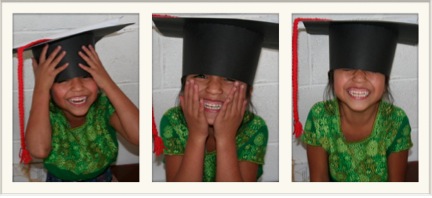
The start of a new school year always makes me a little excited. And last Wednesday was the first day of English classes. (remember Guatemala is on a January - October school calendar…so, dear teacher friends come June I’m always feeling real jealous of you…but for the most part I’ve adapted to this school calendar)
I have been teaching in some capacity for the past 8 years. And I have always been a firm believer that the details matter. When I taught English in Santa Barbara I learned pretty quickly that High School Students are not going to just start spilling information. I know a lot of teachers have students write them a letter on the first day of school, but I never found those to be that genuine. The students that want to sound impressive, do, and the rest that could care less write 5 sentences about their summer vacation. I taught mostly the latter type of students. I wanted something that they could do quickly, finish in class and was slightly fun. I used to have them make a facebook profile. I gave the categories, like…
music most listened to, people who you love, people who annoy you, what you do when you’re not at school, favorite sports teams, last book you read, favorite and least favorite subject in school, If you had 3 wishes, etc.
And I always got honest, sometimes hilarious, responses. I got the details…the little facts and insights into who I was teaching.
Because I know that before I can teach the what I need to know who I am teaching.
For the past 3 years I have been teaching in Guatemala- different culture, different context and, but same purpose. I want to know who I am teaching, before I try to teach the what. I want some of details about their lives. In many ways I find it harder to get those details with little nine and ten years old.
In a culture that values the family unit above all else, the question that I have learned to ask my students on the first day of school is:
Who do you live with?
I find out more from this question than any other. I learned early on that if I ask, who is in your family? Then I could get hundreds of cousins and aunts and uncles and little girls look at me with big eyes, as if to say Miss, I have to draw aaaallllll of my family?
So I have changed the question.
I give the girls a worksheet with a blank spot to draw who they live with. And I often find out as much by what is not there. Like this one: She just has her Papa, hermano, and hermana. As I was walking around, I leaned over next to her, “What about your mom?” She looks up, without blinking, “se murrio.” She died. I am sure she’s not the only one who plays the role of mother in her house.
These are things I want to know.
Another girl draws her dog, chicken and cat. I want to know this, too : )
I love that this girl started to draw her mom wearing a colorful huipil (pronounced we-peel) and corte (the traditional Guatemalan blouse and skirt). She is drawing what her mom, and in fact what almost all most women, wear in her town. She is representing who she lives with. Interestingly enough by the time the girls are in 6th grade, thanks to north American media, fashion and dare I say, Justin Bieber, they no longer draw pictures of women wearing traditional clothes. When asked to draw the people they live with they chose more “American” styles- pants, mini-skirts and tank tops- even tough very few women actually dress this way.
I ask this question and hand out this worksheet on the first day of school because I do what to know them, but I may have a few anterior motives as well.
A Few Simple Teacher Tips I’ve Learned from The 1st Day of School Worksheet
1) I want an easy, non-intimating way to see what they know/remember from the year before
- Two months is a long enough time to forget “eight” and “three.”
- I can get a quick idea and overview about what level the class it at
- And quickly identity what students are going to need some extra help and review
2) I want to see who finishes first and who doesn’t have time to finish
- This is not a timed activity, but I put a little slash mark on the back of the papers of the girls who jump up first and tell me they’re done. These girls usually are the ones who work quickly, and just get things a little faster. I want to know who they are.
- I give a 2-min warning when we’re about to finish and without fail there are usually 5-7 girls who are not even close to being done. I collect their papers and tell them it’s ok. But I make a small dot in the corner of their paper. This reminds me that these girls most likely will work slower and need more support.
- This information is super helpful when I put the girls in groups, because I am able to do mixed ability-level grouping just after the first day.
3) We celebrate little things-like favorite colors and birthdays.
- When we do our birthday unit I have a calendar on the wall with all of their birthdays written on it.
- The school also does a big birthday celebration every trimester to celebrate the girls. Many girls don’t ever get to celebrate their birthdays at home and some aren’t even sure when their birthday is. Like this little girl…I asked why she left it blank. Because I don’t know what my birthday is. I told her that was fine. Inside my heart sunk a little bit.
4) Learning girls’ names when they all have TWO
- When I first started teaching in Guatemala I would look at my roster and see names like this: Rosa Sandra Juarez Chiroc
- How do I know if she was Rosa or Sandra? Her classmates call her Rosa. Her mom calls her Sandra. I was just lost.
- So on the first day of every year I have the kids make their own name tags- and I ask them to underline the name that they want ME to call them. This has saved hours of confusion.
Now my homework is to memorize all these names before next week. I sometimes wish I was teaching full-time, but for now my three English classes is enough with the other work I do. I think no matter what country, what age or what school I will always love teaching and get a tad bit excited for the start of a new school year.
Are you a teacher? What are some your favorite things to do at the start of a new year?
If you’re reading this I am guessing you have either:
a) been on a short-term mission trip or b) sent money to someone going on one.
Now, I could write a whole book about the benefits and limitations of short-term mission trips. I have seen short-term mission trips go very well or very, very badly.
The organization that we work for hosts teams of college students, youth groups, churches and rotary club members throughout the year. A big part of my job is coordinating the details so those groups come prepared and our Guatemalan staff is empowered to host them. We work hard to help these groups understand that their role is to serve, learn and catch a vision of what God is doing here. If you have been one of the people who has come to serve and learn in Guatemala with us, I have nothing to say but thank you. I really enjoy what I do and the people I get to meet.
So, Why Do We Serve?
Now, weather you consider yourself a religions or spiritual person, or have ever taken a mission trip, I’m guessing some of the times that you have felt the best about yourself were times when you were helping other people, right? And I’m guessing being generous once encouraged you to want to keep living generously. Because you probably learned whether consciously or subconsciously that being generous is contagious. It gave you a sense of dignity and empowerment, right? And I believe we were created to serve other people, because maybe it’s only then that we realize that living for ourselves is not the way we want to live.
The thing is having the opportunity to serve oversees or locally is just that- an opportunity. By definition it means you know how to make that happen, you know where to go and how to raise support so that you can serve. Gerber and I are firm believers that GENEROSITY is a POWERFUL AGENT of CHANGE both on an individual level and in a larger community.
However, what can happen in short-term missions is that well-meaning people come from other countries to give, but in the process take away an opportunity from someone else in the host country. There are not simple answers. We fall into patterns that have been reinforced historically, economically and politically for years. Some people or countries (in this case, Guatemala) get very good at being receivers, and others (in this case, the States) become very good at being givers. But we if tried to change it? What if we did something different?
The truth is we need to BE both. Givers and receivers. As individuals, as communities, as churches, as teachers, and countries. We need to be both, givers and receivers.
Guatemalans Helping Guatemalans
This October we want to provide Guatemalan students the opportunity to serve other Guatemalans. These 12 students may not have the same kind of resources that you or I have, but they want a chance to be generous. They want a chance to serve people in their own country, in their own language and own culture.
We’re taking them to a community where we’ve been working the past few months, a village called Coyolate. In the southern part of Guatemala where the humidity sticks to your skin and beads of sweat still form at 8 at night, are about 40 families who live on Government “donated” land. After their own communities disappeared during the civil war, many people fled to Mexico as refugees and when they returned they were given this land in 2000. The community school was just completed in 2004.
We’ll sleep under mosquito nets, and spend days mixing cerement, and building water filters with families. We’ll probably eat a lot of eggs, beans and tortillas and I’m sure if my husband has anything to with it, there be a few chamuscas played on dirt fields with tall sticks marking the goals. We’ll have debriefs in the evenings and some activities with the local school. At one of our recent meetings when we told the students to bring their bathing-suit. They looked confused. Why? They asked. We will shower by bucket without the privacy of walls and curtains. Hence the appropriateness of a bathing suit 
And more than anything that we accomplish during that week, we hope these students will understand that if you say you want to follow Jesus, then what you DO often means far more than what you SAY.
Like any trip it costs money to do this. Food, transportation, supplies, etc.
These students have been working hard, really hard. They have been selling cookies and muffins at recess, hosting garage sale kind of events, asking fellow students and community members to raise money. So far they have raised about $705 — which when you’re doing it by collecting fichas in increments of 2-3 quetzales (roughly 25 cents) that’s A LOT. And we want to match their effort.
Will you help us?*
*Watch this video they made to find out more or go to here and scroll down to Healthy Communities and write “Student Mission Trip” in the note.
…some days end in tears.
Yesterday was one of those days.* My 6th grade class had been unusually difficult. Of course, it wasn’t the whole 6th grade class, just a handful of pre-pubescent boys with emptied out plastic pen containers, perfect for shooting spit wads. I was trying to teach the difference between “do” and “does” and they were trying to teach their compañeros how to make weird burping noises while shooting wads of paper.
boys. boys. boys.
• • •
{doesn’t matter what country or language. spit wads and burps are universal }
• • •
I made them stay after class and gave my best “if-you-do-that-again-talk” in my angry (spanish) teacher voice. I signed their agendas. Wrote notes to each of their parents. And watched them leave one by one.
The door closed. And the tears came.
There is something about being a teacher where one bad day can make you feel like every day is a bad day. If you’re a teacher you get this, right?
I believe teaching is a calling. Good teachers are called to be teachers because they have a love for students and a passion to teach. But teaching is a unique profession where you spend hours and weeks with a group of kids, investing day-by-day for 10 months of the year, sometimes with few tangible results.
I find it’s hard to measure sucess as a teacher. And maybe this is true for other professions as well. Counselors, pastors, parents and social workers probabaly feel something similar. But that’s why one bad day, one discouraging class, or eight spid-wad-throwing-boys can make you doubt and question and occasionally cry.
I’ve always said good teaching involves meeting students where they are at, in order to challenge them to get where they could be.
I guess my struggle is how do I meet 6th grade boys where they are at?
suggestions welcome.
have a wonderful weekend!
*note: even though many of you are currently enjoying summer break, in Guatemala our “summer” doesn’t start until October. So in US school-calendar terms we’re in about the equivalent of “March” right now : )
When I came to Guatemala my first DIY project was this Pottery Barn inspired chalkboard. I made it 1) to fill up empty wall space in my apartment and 2) to write down my weekly schedule and things to-do.
Well, apparently my weekly schedule has not changed since March. If you look closely at the picture you’ll notice that I have written “Steph comes (sister)” and “Andrew comes (brother).” That was a good three months ago! It’s not that I haven’t done anything different since then, it’s just that the idea of planning out my week and writing some weekly schedule doesn’t happen as often. At least not in the same way I am used to.
A New Schedule*
The word schedule here is always accompanied by an asterick that signifies: *tentative, this may change. The school where I work, the relationships I have and the country where I live often operate within this assumption. So in my effort to live here and live well I have adapted (well, I am still adapting- it’s an on-going process really). Of course, I still like to make plans and schedules, however I now know that on any given day things may change. I will always be a J (for those of you who speak Myers-Briggs) and I am convinced that type J people may get more done in life, but I am also learning that they (ok, I) can waste a lot of energy and stress planning, preparing, worrying and then re-doing when something doesn’t go as planned. Sometimes I envy type P people (i.e. my boyfriend) because they can respond to changes with an ease, flexibility and even a little excitement! (which I don’t think I will quite ever understand)
The Things That I Would Have Written on My Calendar During the Past 3 Months
Camp
We took our 7th-9th graders (Basico) to a three day Campamento about 2 hours from the school. And they loved it. The crazy games, sleeping with your best friends, the campfire, meals together, worship nights, prizes, dress-up night and probably just being away from home. I enjoyed most of it. Minus the 5:30 am wake-up calls with a trumpet. (not kidding, 5:30 in the MORNING!)
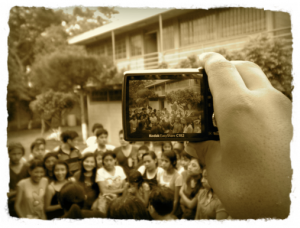 There is something special about taking kids away from their normal surroundings and putting them together for 36 hours. Good things happen. Funny stories. Hopefully some spiritual growth and learning. And powerful conversations. I kinda thought I had “finished” my years of camp when I left high school ministry in Santa Barbara. Guess I was wrong.
There is something special about taking kids away from their normal surroundings and putting them together for 36 hours. Good things happen. Funny stories. Hopefully some spiritual growth and learning. And powerful conversations. I kinda thought I had “finished” my years of camp when I left high school ministry in Santa Barbara. Guess I was wrong.
Teaching
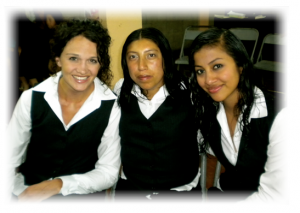 Teaching English continues 3 days a week at Vida y Esperanza with these lovely maestras and 1 day a week at Proximos Pasos with these precious girls (see below). I will always love teaching; however, it has been a challenge adjusting to a new system and a different way of teaching. Not to mention that I now teach in “Spanish,” even though I am teaching English.
Teaching English continues 3 days a week at Vida y Esperanza with these lovely maestras and 1 day a week at Proximos Pasos with these precious girls (see below). I will always love teaching; however, it has been a challenge adjusting to a new system and a different way of teaching. Not to mention that I now teach in “Spanish,” even though I am teaching English.
Teams
This has probably been one of my favorite parts of work so far. Getting to coordinate and plan (“plan” is used loosely here) when teams from the States come to severe here for a week or two. I like being able to connect with them and be a bridge between the country where they and I come from and the country where I now live. I like listening to their ideas, questions, and observations. And I like being able to explain and share a little what I’ve learned about Guatemala and how God is a lot bigger than country lines and languages. This team of stunning college students is here for a month working with Gerber and another staff member building water filters and latrines in a community near Antigua. I get to join them for dinners, conversations and whenever translating or touring in Antigua is needed.
Back to My Schedule*
It’s Monday afternoon and I am going to attempt to write on my the calendar for this next week. Of course with an * next to everything that is planned.
What’s on your schedule this week?











